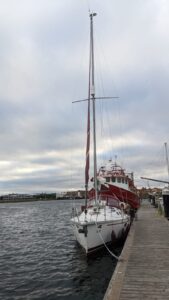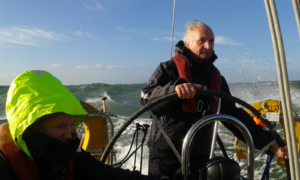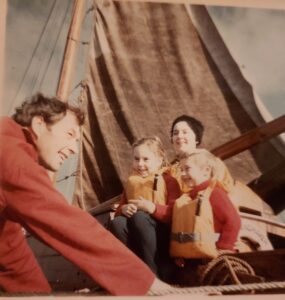 Life on the Mud
Life on the Mud
Rod Elwood is currently studying his RYA Day Skipper Theory with my evening class, and he produced this book written by his mother, Rosalind Elwood. He lent it to me and I read through eagerly, it’s a fascinating book, well written complete with humour. Mum tells of a mud berth life onboard a converted Dutch fishing botter in Essex (an area I know having spent over three hours grounded at Brightlingsea, life onboard at a 30 degree tilt). I sometimes had to resort to the Internet for explanations e.g. ‘tricing line’. It’s a fascinating read, can you imagine bringing up two small children onboard a boat. I hope to meet Dad, still around at 99, sometime for a sequel. Botter Living![]()
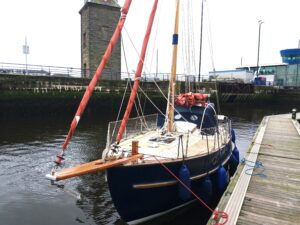 5 Different Boats in 7 Days
5 Different Boats in 7 Days
Incredible when I look back. Day 1; Own Boat tuition on a lovely gaff rigged Yarmouth 23 Impulsive II. Mike has made it rather nice down below and so he should as he runs an upholstery company Compleat Interiors. Day 2; a Day Trip on Pure Gallus, my most popular course at the moment. This time with the eccentric Hassall and family. Day 3; Own Boat Tuition again, this time on a Hunter 27 Jetstream with Stephen. Day 4; a chartered boat out of Oban, Frolika, with the two Peters. Day 5; this boat decided not to go into gear forwards and we had to get back to a Tobermory mooring under sail. A bit tricky especially with a full jib flogging – amazing how many other boat owners on their moorings came out to watch! The gearbox could not be repaired and we had to await a replacement boat, which arrived on Day 7; Morpheus a smaller version of Pure Gallus made the fifth boat in seven days. Day 6? Whilst stuck in Balamory we decided to hire electric bikes, a first for me. I say a ‘thank you ‘ to both Peters for withholding information regarding the turbo setting and I puffed hard up the steep hill leading out of town 🙁
 All was not sadness though and we enjoyed a mooring at Ornsay and a sail up the remote Loch Doune before setting off for Canna in a rising wind. A short stop in Rum produced an amazing change in the wind and Canna beckoned, together with a superb meal of lobster, crab, langoustines and more. In the fading light more adventures continued as we had forgotten to top up the outboard’s fuel and hence it was oars time on the sailor’s most dangerous journey. A stop enroute home to Oban at Loch Aline produced a spluttering tap and we were out of water! Morpheus
All was not sadness though and we enjoyed a mooring at Ornsay and a sail up the remote Loch Doune before setting off for Canna in a rising wind. A short stop in Rum produced an amazing change in the wind and Canna beckoned, together with a superb meal of lobster, crab, langoustines and more. In the fading light more adventures continued as we had forgotten to top up the outboard’s fuel and hence it was oars time on the sailor’s most dangerous journey. A stop enroute home to Oban at Loch Aline produced a spluttering tap and we were out of water! Morpheus  wasn’t supplied with the necessary hose so we remained the great unwashed and unshaved before presenting ourselves to wives on the Saturday (one Peter being in virgin condition after spending his £2 on a shower 5 days previously…)
wasn’t supplied with the necessary hose so we remained the great unwashed and unshaved before presenting ourselves to wives on the Saturday (one Peter being in virgin condition after spending his £2 on a shower 5 days previously…)
Outrage in the Seine
Rob Langley had a challenging experience in France when sailing with his wife and reports;’ The estuary of the river Seine is wide, sandy and mostly very shallow. The main shipping lane goes up to Le Havre, where Port Control is based, and a narrow secondary channel leads in from the sea up to Rouen. After a few days in Honfleur, Helen and I were motoring westwards down the Rouen channel towards the sea in our 37 foot yacht Pendragon, into a westerly force three, weather fair, sea state slight.
The local VTS rules require pleasure craft to stay just outside the red buoys north of the shipping channel, where the depths were about 6 to 10 m. Significantly, the south side of the channel was bordered by dangerous rocks and shallows.
There were several small fishing boats of about 40 feet working in the areas to the north of the channel, and we noticed that one was gradually inclining west south-west towards shipping channel, and so we speeded up to 7 knots to keep clear. The fishing boat also increased speed, maintaining its gradual approach. Through the binoculars I could see that they had their trawling gear out behind them
Seeing this I slowed us down to 3 knots, but the fishing boat also slowed down, and was now on our quarter getting steadily closer. I looked hard for the boat’s name but it was very difficult to make out. Very worryingly, the fishing boat now reached the edge of the shipping channel pushing us south into it. Helen turned us through 180°, back east towards Honfleur. The fishing boat at this point turned on its AIS transponder, identifying itself as the Vaisseau de Peche Rosenah.
After Rosenah had steered along the north edge of the channel for a period, we turned west again and I went below to check the chart when I heard Helen call out –
Rosenah was now inside the shipping channel only 40 metres away, still with its trawl lines out, about to either hit us or cross our bows with its lines. I hailed them on VHF 16, knowing that the Le Havre Port Control would be listening:
“Vaisseau de peche Rosenah, Vaisseau de peche Rosenah ici Pendragon, vous etes dangereux, vous etes dangereux, arretez, arretez maintenant ! Over! »
She immediately swung away and reduced speed, having given the English a serious fright. Whether this was deliberate intimidation against an English boat, or an attempt to set up an insurance claim for their trawl gear, we can’t say, but there was nothing accidental about their behaviour. We believe that they switched on their AIS as part of the insurance claim plan, but it enabled us to foil the attack by naming them over the VHF to the Port Control.
After we had cleared the channel we close-hauled to Ouistreham, and received a warm welcome from the French yachties on the pontoon, and the friendly, competent staff in the Bureau du Marina – back to normal French courtesy and hospitality’.
Chris Robson reports; ‘We are a band of sailors self-styled as the Phat Buoys. We have sailed together for 23 years in different locations around the continents of North America and Europe seeking adventure and challenges in remote destinations such as Iceland, British Columbia, the Channel Islands and the Orkneys. We stay well away from palm trees, always sail on the “shoulder” of the season and visit a new sailing ground each year. This year we decided upon the Inner Hebrides, the heartland of Scottish cruising. Early reference to the Clyde Cruising Club’s sailing directions (essential reading for this trip) made me realise that a call to my long-suffering sailing tutor, Melvyn Wallhead, for a tidal navigation refresher would be helpful, indeed necessary!
Arrangements were made, and facilities established in the board room of my offices in Jesmond for two half day courses which gave me the confidence to go ahead with the planning for this trip. We chartered Aqua Vite, an Oceanis 41.1 out of Craobh (pronounced Kroov) just south of Oban. I stressed to my crew mates that my aspirations for the week were entirely dependent upon the fickle Scottish weather!
My prayers were answered, and we enjoyed favourable winds of 15-20kts most days with a few gusts dropping in to keep us on our toes. Most importantly the wind direction was near perfect every day for our meanderings around these beautiful islands. We quickly learnt the importance of keeping our eyes focussed on the local weather systems which could whip up near storm force gusts which made for some exciting activity, deploying the boats newly fitted third reef on some occasions.
Our course took us south down the Sound of Jura leaving the renowned Dorus Mor to port and the even more famous Corryvreckan to starboard. A steady north westerly wind assisted with an ebbing tide gave us good progress for the 45 miles to Port Ellen. This interesting harbour lies at the south end of Islay, an island which is becoming known as the Disneyland of distilleries. This was our only “alongside” overnight stay. Thereafter we were always at anchor, spoilt for choice on the west coast of Jura, Ross of Mull, Iona, Colonsay, Oronsay and Seil.
The Abbey on Iona was high up on our list for a visit. After topping up with water at Scalasaig on Colonsay, an interesting berth next to the ferry terminal, we set sail for the west end of the Ross of Mull. By now the wind had helpfully backed around to the south making for a quick but very lumpy passage. We tiptoed through Torran Rocks and left Rankin’s rocks to starboard to find the barely visible entrance to Tinker’s Hole, a beautiful, isolated anchorage which is well worth a visit. (image here)
After dropping anchor next to the ferry ramp, the visit to the Abbey on Iona involved a classic Phat Buoy onshore picnic taking in the peace, beauty and heritage of an island which is considered to be one of the most important places in Scottish history. An extra day negotiated on the charter allowed us the treat of heading north towards the Oban and finding our way, very carefully, into the stunning, much photographed anchorage of Puilladobhrain at the north end of Seil Island. After diligently calculating our depth with a falling tide, we tackled the half hour hike to the Tigh An Truish hostelry next to the Bridge over the Atlantic to enjoy some local hospitality. Stumbling back in the dark, it was a relief to see Aqua Vite still afloat, awaiting our return!
For our last day, the wind, as if to order, had veered to the north to push us gently with the tide down the Sound of Luing regarded by many as a stately river. Just as we headed north back to our base at Craobh, the wind picked up and allowed us to enjoy a final flurry of tacking upwind to finish off a very special trip.
For this trip, the Phat Buoys were Chris Robson, Simon Tyler and Andrew Wagstaff (Brits) and Canadians Mike Scrivens, Warren Creates and Boris Ulelha.’[space_2
Emre’s Turkish Delight
Emre finally made it to Turkey the home of his parents and is shown bearded here with them and Jonathan Hetherington. During this epic voyage he had many experiences set out more fully in the article below
‘I wanted to take my 36ft Bavaria Sailing Vessel to Turkey and started searching for 2 crew to join me. The voyage is a long one, total around 3,300NM, so any crew who was able to join me for the whole duration would have been a bonus. I advertised my voyage on Crew Finder page on Facebook. My minimum requirement was Competent Crew certification.
Quite a few people expressed interest and after a chat on the phone, I welcomed some of them to join but after a few days, I was always getting a message from them saying they cannot make it due to whatever reasons they had. Having said that, one guy (let’s call him Crew A) was keen and remained keen till the voyage started. He said he has Comp Crew Certificate and also participated in races. Plus he agreed to join all the way until Marmaris as well. So he sounded like a good choice.
Crew B, also a comp crew, agreed to join until Gibraltar, which was also fine. I could then carry on with A all the way to Marmaris. On the Easter weekend, I sailed my boat with crew B to Portsmouth, which took 3.5 days. It was a demanding leg with both of us only on board, we were beating into winds and waves about 75% of the time. Norfolk area was horrendous when the waves and tide is against you. You just can’t make any way forward. But you fly when the tide turns! I enjoyed sailing with Crew B, he was great, following the rules, getting on with whatever task he was given and all went just fine.
On 30th May, Crews A and B joined me in Portsmouth and we started our voyage together towards Marmaris. The conditions were good, wind was taking us all the way towards NW France and the winds were NNE’ly for a number of days to take us downwind to south via Bay of Biscay. Bay of Biscay was a concern due to its reputation, however it turned out really good. We set the sails, predominantly goosewing, and winds just pushed us nicely down towards North Spain. My plan was to leave Portsmouth and sail non-stop to Bayona in Atlantic Spain (total 635NM), since I needed minimum 600NM for a qualifying passage for my YM Ocean oral exam.
Anyway, all started pretty good until I noticed that Crew A was not following the rules I had mentioned him, such as not going to bow alone, not urinating from stern of the boat, not changing the course unless absolutely needed and keeping me informed of any abnormalities, etc. I also caught him asleep during his watches on more than 1 occasion. This guy was too much of a free spirit and did what he pleased which started to worry me for my and my crew’s safety. I felt like I constantly had to keep an eye on him and warn him, which started to make a bitter atmosphere in the boat.
One night, after we left Bayona, on our way towards Gibraltar, I went to bed when we were motorsailing and i noticed the engine revs were reduced. I got up to see if all was OK and it was his watchkeeping time. He was sitting down below in the saloon, reading a book when I asked him whether all is OK and he said he reduced the speed because there is thick fog outside. I went to cockpit and he was right. It was quite a fog and he did the right thing reducing the speed. I asked him, if there is fog outside, what are you doing down below reading a book??
He replied, no point to be above, since he could not see anything. But surely that’s not the point. I have no radar on board so in such conditions, I told him that firstly he should have made me aware of this situation. Then he should be outside, fully alert, listening to the sounds of engines or fog horns and passed him our fog horn. He didn’t know the fog sign for a sailing vessel and I told him it is one long two short. He told me this is a toy and he does not respect my decision to insist him to stay out in the cockpit in these conditions. We had an argument about the safety and rules in the boat, but at that moment, it was clear to me that this guy was a hazard to have on board. He was not reliable and also not following the rules.
His overconfidence and lack of even basic knowledge was putting us all in great danger out at sea which was totally unacceptable. Following morning, I told him that it was time for him to leave the boat. I explained him the reasons but whether he understood or agreed with me, I don’t know. Probably not because I am convinced that he thinks he is a great sailor.
At that time, Crew B knew we were going to be only 2 of us on board and he said he had really hard time sailing 2 people from Newcastle to Portsmouth and whether he can also leave the boat with Crew A. I said that is fine and dropped them both at Figueira da Foz in North Portugal. From there on, I sailed solo until Gibraltar which took me around 4 days, non stop.
During my solo sail, I tried to keep outside 100m contour, since it was full of lobster pots. During the night sail, I was sleeping in 30min intervals with reduced speed, which worked fine for me. In Gibraltar, a good friend of mine (also a sailor) joined me. I sailed with him for a week during my YM Coastal practical exam, so I knew his skills and character. In Sicily, another friend (in fact another “victim” of Melvyn) joined us as well (with Jon, we sailed for 12 days from West Coast of Scotland so again, I knew him and his skills). The passage with crew that I know went so much better and was great fun! We knew each other already and having sailed in the past definitely helps. I feel much more comfortable sailing with people whom I know.
Learning points and recommendations from my experience:
⁃ before taking on a new crew, try to sail with them and observe their behaviour. See if they will be a good crew, listening and understanding what they are asked to do or will they be a hazard at sea to you, themselves and to other boaters
⁃ Never rely on crew 100% and assume they will stick to their words and stay with you as you pre-agree, especially if you do not know them well. They can leave you midway for any reason. In my case it was Crew B, who wanted to leave the boat before we reached our pre-agreed destination of Gibraltar. I even heard a story where a crew member ran away at a port of call without even informing the skipper.
⁃ Solo sailing and being exposed to winds with strong gusts and waves from the wrong direction taught me to be “patient”. Conditions will get better soon.
⁃ Make sure you carry enough spares. I had to change the impeller, navigation bulbs and the snapped autopilot belt on the way as well as having to top up the engine oil from time to time. I also used a sail repair tape on my genoa to prevent further rip on the sail. If you are into fishing, make sure you have spare lures. I lost 4 lures during this trip. I was about to catch 1 fish with the last one before it got lost but it managed to escape just before I could get it onboard.
⁃ Also remember to take additional chargers for mobile, laptop etc. they corrode quickly if left out in the cockpit. Cockpit gets soaking wet during the night from condensation.
⁃ I am a big fan of my AIS transceiver. If you are planning a long passage especially with shipping lanes involved, get an AIS system installed if you don’t have one. It is a massive help. However never rely on it fully. I encountered countless fishing vessels without AIS, especially around Atlantic Spain and Portugal.
⁃ Garmin InReach helped me loads. You can send and receive text messages and emails out at sea as well as downloading accurate marine weather. On a number of occasions, I changed my sailing plans and route while I am at sea, based on the weather info I was receiving from InReach, which enabled me to reach my destination faster and earlier.’
Man Overboard!
Jonathan Hetherington, now Yachtmaster Jonathan, reports; ‘Thought it was worth sharing a Man Overboard incident I was involved in at end February. Thankfully all went well and the casualty recovered quickly with no ill effects, but there are some good points of learning and reflection at least for me, and they may help others. We race a Hunter Sonata 23 in the Windermere IRC winter series. There are 18 yachts registered from 7 different classes which makes for competitive but fun sailing in a handicapped fleet. We were racing 4 up in bright cold, good, but occasionally gusty conditions which is fairly standard for lake sailing (although it is normally raining)! The wind shifts around, and you can go from being dead calm to fighting to avoid a broach within 50 metres.
We had just finished the 3rd race of the day having come through the line with spinnaker up on a port tack beam reach, and were then bearing away to get the spinnaker down and reset for the last race of the day. We were feeling pretty pleased with ourselves; the sun was shining, things had gone well, and we’d had our best finish of the day. The foredeck crewman was unhooking the spinnaker guy line from the pole when one of those aforementioned gusts filled the spinnaker, yanked the pole forward and heeled the boat. The foredeck man, who was holding the pole, overbalanced and fell back over the port guardrail – straight into the water. Disaster!
We clicked into action pretty quickly with shouts of man overboard and stop the boat – which wasn’t easy as the spinnaker was still up. First job – drop the spinnaker, which 2 of us did very hastily while the helmsman kept an eye on the MOB whose life jacket, thankfully, inflated straight away. Then a quick turn to get back to the MOB under mainsail alone. As we turned I remembered that these boats have a closed high transom, and no fixed ladder. How would we get him out? It was then I remembered the race briefings from the start of the season – all boats must stow recovery ladders. I quickly went down below and recovered the hook on ladders, slung them over the transom just in time for the MOB to climb up himself with a little assistance from the rest of the crew. By this time the safety boat had arrived together with another race boat to offer assistance. This was great reassurance even though we had managed to recover him ourselves. I checked the recovered MOB over for early signs of cold water shock and we headed back to the marina and dry land 20 minutes later.
There’s a few points of learning and reflection from this incident. Firstly a MOB can come out of nowhere. It was a nice day, we’d finished a race and were not rushing or cutting corners, but it still happened.
Wear a life jacket and make sure it is in good condition. We have to, as required by race rules, but it would have been much more serious if he wasn’t wearing one, or it hadn’t activated. They really do keep your head high up out of the water and minimise the amount of water ingested or breathed in.
The water was cold (5 degC). This was colder than at Tynemouth on the same day (I’ve just checked – 6.6degC) so having multiple layers of microfleece clothing and salopettes really minimised the cold water shock. Nevertheless the wet clothes weighed a lot and held a lot of water, and had we been further from dry land he would have got very cold, so a spare set of clothes is invaluable.
Safety briefings. They are important and can make all the difference. This year the race rules required us to carry recovery ladders. It was mentioned in the start of season safety briefing, and we had them stowed on the boat. Because of that briefing I remembered we had them, and it meant we recovered the MOB much more quickly than if I wasn’t aware.
Coastguard. The safety boat contacted the coastguard who offered recovery assistance, advice, and took a lot of details as to the condition of the MOB to check he was ok. Although the whole recovery took less than 5 minutes, it might not have, or the MOB could have been in a worse condition. So – always call the coastguard. However confident you are of sorting the problem out yourself you may not remember to run through all of the checks while you are in the thick of it.
Lastly – do you have a plan of how to get a MOB back on the boat? We have all done MOB drills before, but getting a cold wet real person back on board is different to hooking an orange MOB buoy. Work out how you are going to do it, and have the equipment ready and crew briefed on how to use it.’
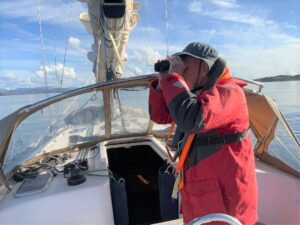 Peter Millican & Peter MacLaren, ‘Peter and I have just returned from the most amazing week sailing on the west coast. Originally we planned to go in May but this was cancelled due to restrictions. Alba sailing offered us a week in late September in a Dufour 425 GL which was almost 12 tons in weight compared with the Sun Odyssey which we originally booked which was nearer 7 tons. This proved to be an unplanned blessing as Pollyanna behaved incredibly well in the exciting conditions of the week.
Peter Millican & Peter MacLaren, ‘Peter and I have just returned from the most amazing week sailing on the west coast. Originally we planned to go in May but this was cancelled due to restrictions. Alba sailing offered us a week in late September in a Dufour 425 GL which was almost 12 tons in weight compared with the Sun Odyssey which we originally booked which was nearer 7 tons. This proved to be an unplanned blessing as Pollyanna behaved incredibly well in the exciting conditions of the week.
We left Dunstaffnage around 16.00 on Saturday not a cloud in the sky and no wind to speak of so we motored to Lochaline on the sound of Mull and hitched onto one of the visitor moorings for the night. Leaving next day at around 7.00 we set out for Canna 45NM away. Predictwind which we relied on all week said that there was little wind in the Sound of Mull then 10/15 Knots SW from around 9.30 across to Canna. Consequently we motored to Tobermory then had a broad reach all the way to Canna. I took two particular pieces of kit to use on Pollyanna, firstly a length of chain to throw around a mooring buoy having been in trouble on a previous trip when we had to tie on to a big mooring buoy with no pickup in a force 6. On that occasion we lassoed the buoy with two strong warps but by morning one was almost chaffed through and the other looking very worn. Secondly a gybe preventer made by Wichard. The chain was never needed but we had the preventer rigged up for the whole week and it proved invaluable. Whilst we never approached an involuntary gybe the preventer stopped the constant flapping of the boom when sailing downwind particularly in a fair swell and I am convinced that we improved our boat speed because of it.
The sail to Canna was a dream, perfect winds and beautiful billowing clouds. A long broad reach when we were escorted by dolphins and minke whales for much of the way. Predictweather was now telling us that whilst Monday looked exciting and Tuesday looked scary. The barometer was predicted to drop from 1024 to 994 and the attached image shows the predicted wind pattern. It was clear that we would not be sailing on Tuesday and we needed a safe place to batten down the hatches. So we planned to sail on Monday from Canna to Shieldaig in Torridon where we knew there were two visitor moorings in a relatively sheltered position.
We left Canna just before dawn for an 80NM sail around the tip of Skye with two reefs and a reduced genoa. The winds were predicted to be in the low twenties with gusting up to just over 30 knots form the S and that is how it turned out. The 13hr trip was 12 hrs of sailing, fifteen minutes motoring out of Canna and 45 minutes motoring into Torridon. We had a downwind sail up into the Minch to the tip of Skye then a broad/beam reach across the inner sound. Pollyanna performed faultlessly, the most exciting stretch being around the NE tip of Skye when we had a 4.5 Knot current against us and a 20+ Knot wind behind and the sea was wild. The bow was dipping into the sea as we hurtled along at up to 11.5 knots through the water. Interestingly we sailed almost all the way using the autopilot which even coped with the tide race.
Coming into Shieldaig one of the visitor moorings was taken by a local fishing boat but the other was free and we hauled up the pickup with relief. The wind was steadily building as we put our heads down but the worst was to come during Tuesday. During the morning I saw the anemometer reading 50.5 knots, there were twisters crossing the bay and the back canopy on the Dufour was ripped out of its fixing. Fortunately no other damage occurred, by 16.00 the wind was dropping and by 19.00 it was almost still. Next day dawned still and clear and we set off for Isle Ornsay on Sleet. 45 NM plus tacking and we recorded around 55 NM through the water. We tacked down the inner sound into a 10 Knot Southerly wind and cruised through Glenelg at low tide with almost no current.
Next day the wind was forecast to turn northerly at circa 10 Knts till noon then drop away and return still northerly at 15knts around 15.00. So we reached till 12.00 down to the SW tip of Skye then motored between Eigg and Rhum and sailed on a beam reach to a peaceful anchorage in Loch Na Droma Buidhe where we were joined by three other yachts after seeing just three since leaving Canna. The photo shows sunset from the anchorage. Friday our final day gave us yet another glorious sail along the sound of Mull as the winds gradually built from 15knts to 20+ knots after we passed Lismore light and crossed the Firth of Lorn back to Dunstaffnage. A memorable week!
Two Fingers to a Windlass
Colin Banks witnessed a rather nasty accident whilst sailing in the Med; ‘There was a scary moment this morning as I was chilling in the shade at the marina. I was watching a Greek hand balling his anchor chain in as his windlass was faulty. From there I heard an almighty scream so I ran to his boat to help him as his fingers were crushed into the windlass by the anchor chain. I managed to free him within seconds but his fingers were snapped and crushed. Paramedics came and he was airlifted off. They reckon he will lose at least two fingers. Me and an old hand in the port done our best to put the boat right. In doing so we found that the windlass control was shorting out due to lack of maintenance this resulting in making the windlass of it’s own accord to wind in and out and that’s what happened to the man while manually hand balling. This is an important wake up call to the real every day dangers of working a boat.’ PS ‘The accident isn’t as bad as first anticipated. He got away lightly with one badly broken finger and severe cuts but I reckon his holiday is over.’
Bill Hill is an adventurous sailor who regularly sails a variety of areas. This time, part of his week was spent stormbound in the English Channel. Rarely do images show the sea strength, but this is one. Bill has recently completed his Yachtmaster Ocean Theory successfully and it looks like he has his eyes on the ‘top of the range’ Ocean practical ticket. An excellent, detailed, report on his trip can be followed on this link. Bill Hill




